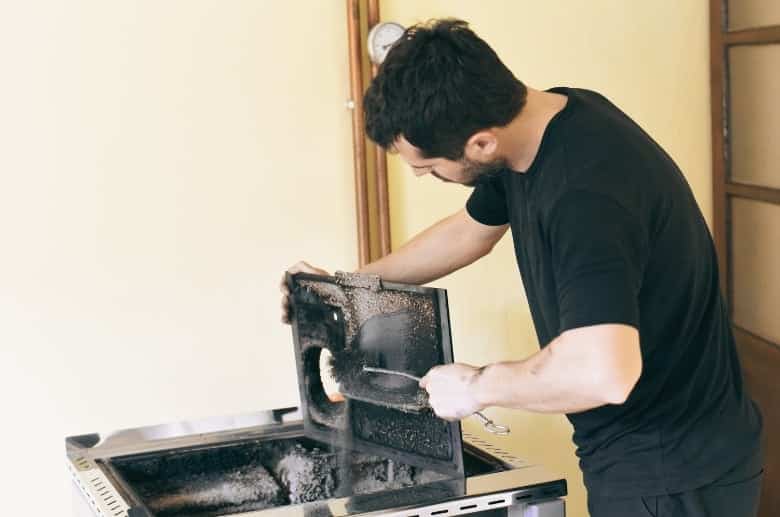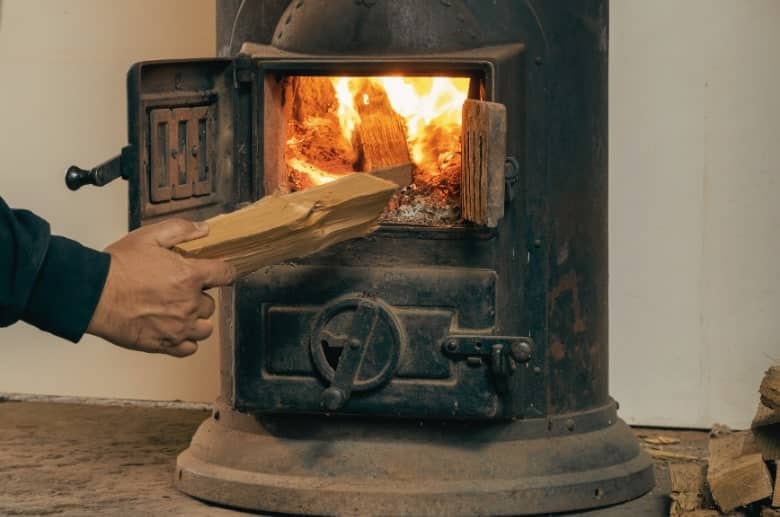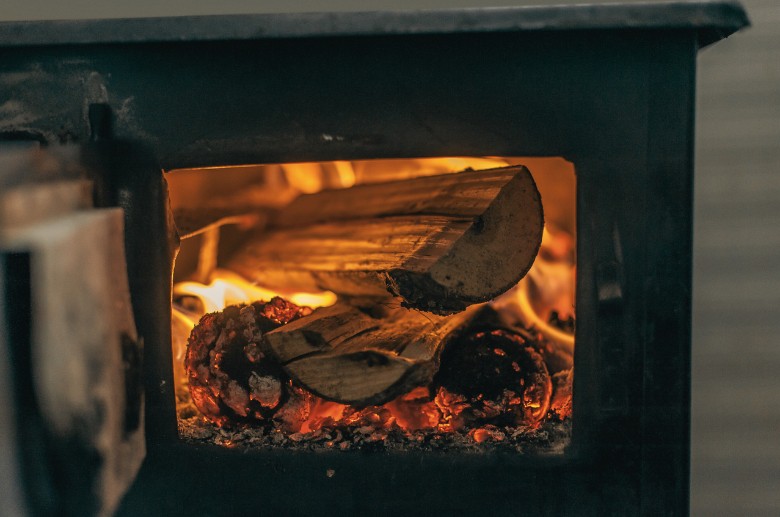Old wood-burning stoves can be charming and functional, but they can also pose some common issues. These may include lighting difficulties, inefficient heating, and potential hazards like chimney fires.
However, with proper usage and maintenance, they can provide warmth and comfort for many years.
Think of it as a vintage car – it may require a bit more TLC to keep it running smoothly, but the rewards are worth it. So grab your kindling, and let’s show you how to use an old wood burning stove!
Are Old Wood-Burning Stoves Safe?
Old wood-burning stoves can be safe, but it is important to take certain precautions, unlike other types of stoves, to ensure that they operate efficiently and do not pose a fire hazard. Here are some tips on how to use an old wood-burning stove safely:

- Check for damage: Before using an old wood stove, inspect it carefully for any signs of damage, such as cracks, holes in the metal, or missing firebricks. If you notice any damage, have it repaired by a professional before using the stove.
- Install a chimney cap: A chimney cap helps prevent debris and animals from entering the chimney, which can cause blockages and create a fire hazard. Make sure your old wood stove has a chimney cap installed.
- Use dry, seasoned wood: Wet or green wood can create excessive creosote buildup in the chimney. Furthermore, it’s crucial to avoid burning cardboard in wood stoves as it may introduce unexpected hazards and inefficiencies. Creosote buildup is a major cause of chimney fires. Use only dry, seasoned wood in your wood stove.
- Keep the stove and chimney clean: Regular cleaning of the stove and chimney is essential for safe operation. The EPA recommends having the wood stove, chimney, and vents professionally inspected and cleaned yearly.
- Be alert to smoke: The smell of smoke indicates that a wood stove is not operating efficiently. This can be due to a blockage in the chimney or improper operation of the stove. If you smell smoke in your home, stop using the stove immediately and have it inspected by a professional.
An old wood-burning stove can be a safe and efficient way to heat your home. However, it is important to remember that regular maintenance is key to safe operation and that the EPA recommends having your stove professionally inspected and cleaned yearly.
——
Do You Need to Hire Chimney & Fireplace Expert?
Get free quotes from qualified experts near you. No commitment required!
——
How to Use an Old Wood Burning Stove to Heat the House
Using an old wood burning stove to heat your house can be an effective and cost-efficient way to stay warm during the colder months. Ensuring the stove is in good working condition and safe to use is essential. Here are some steps how to use an old wood burning stove:
Step 1: Inspect and Clean The Stove

Before using an old wood burning stove to heat your house, inspect it and clean it properly. Start by checking the stove for visible damage, such as cracks, excessive rust, soot, or creosote buildup. These issues can affect the stove’s safety and performance, so addressing them before use is important.
Failing to check for damage or rust can lead to safety hazards and poor performance, including reduced heating efficiency and increased fire risk. According to EPA research, about 4000 residential fires each year are caused by wood-burning stoves, so take safety precautions seriously.
Remove any debris or ashes from the stove before using it. This step ensures proper airflow and prevents the buildup of creosote.
Step 2: Prepare the Stove

Selecting the right firewood matters when using a wood burning stove to heat your house. Always use seasoned wood which has been dried for at least six months, as wet or unseasoned wood can lead to poor heating performance and dangerous creosote buildup.
This is because wet or unseasoned wood contains excess moisture, which causes it to burn inefficiently and produce more smoke, leading to creosote buildup in the chimney, a potential fire hazard. On the other hand, seasoned wood can reduce creosote buildup by up to 50%.
Never burn trash or treated wood in your wood burning stove, as these can release harmful chemicals into the air and damage the stove’s interior.
When preparing the stove, stack the wood properly inside it. Use small pieces of kindling to start the fire and gradually add larger logs as the fire grows. Always light the fire safely and use caution when adding wood to the stove. Try these tips:
- Use crumpled newspaper or fire starters to ignite the kindling,
- Open the stove’s damper to allow air to flow through, and
- Avoid overloading the stove with wood, which can smother the fire.
Step 3: Adjust the Chimney Damper
The chimney damper controls the amount of air that enters and exits the chimney. When using a wood burning stove, it’s important to adjust the chimney damper to ensure the fire burns efficiently and safely.
To properly adjust the damper, start by opening it fully before lighting the fire. This allows for proper airflow and helps the fire build faster.
Once the fire is burning well, adjust the damper to control the burn rate. If you want a hotter fire, you can open the damper fully. You can partially close the damper if you want a slower, cooler burn.
It’s important to note that leaving the damper fully closed for an extended period can result in a buildup of creosote in the chimney, which can cause a chimney fire. Adjusting the damper carefully and regularly will ensure proper airflow and efficient burning.
Step 4: Maintain the Fire

Maintaining a fire requires some basic knowledge of how the stove works. Adjust the air intake to control the stove’s airflow and temperature to keep the fire burning consistently, which is critical for optimal combustion.
To maintain the fire, you must regularly add wood to the stove. When adding wood, do so gradually so as not to smother the fire. Smothering the fire can cause incomplete combustion, leading to the production of more creosote.
Proper wood-burning stove operation can increase efficiency, so you can heat your home more effectively using less wood. To prevent creosote buildup, clean the ash regularly. Removing the ash increases airflow, leading to a more efficient burn.
Use stove gloves when operating the door handle and air controls of the stove and when placing logs into the fire. This helps prevent burns.
——
Do You Need to Hire Chimney & Fireplace Expert?
Get free quotes from qualified experts near you. No commitment required!
——
Wood Burning Stove Safety Tips
If you have an old wood burning stove, here are some tips on how to use it safely:
- Before using your old wood burning stove, have it inspected by a professional to ensure it is in good condition and safe to use.
- When starting a fire in the stove, use only dry, seasoned wood that has been properly stored.
- Avoid leaving the stove unattended when the stove door is open, and the fire is burning. Always close the door securely before leaving the room.
- Ensure all smoke detectors are in working order and install carbon monoxide detectors. Placing them 9 to 11 feet from the stove is ideal.
- Keep all flammable objects away from the wood stove, including furniture, curtains, and household items.
- Keep a fire extinguisher nearby in case of emergencies.
- Use proper tools to handle the fire and ash. Use fireplace gloves, tongs, and a poker to add wood to the fire and remove ash from the stove.
- Use a stove thermometer to monitor the approximate temperature levels, which should be between 250 and 600 degrees Fahrenheit (121 to 316 degrees Celsius) for optimal combustion and efficiency. This helps to reduce tar, condensation, and soot formation in the chimney.
- Considering an upgrade? Converting your fireplace into a wood stove is a smart move to boost your home’s heating efficiency and safety. This change marries the traditional charm of a fireplace with the advanced technology of modern wood stoves. It’s important to consult with a specialist in transforming fireplaces to wood stoves to ensure the conversion meets safety standards and enhances your heating system’s performance
By following these wood burning stove safety tips, you can enjoy the warmth and comfort of your old wood stove while keeping your home and family safe from potential hazards.
Conclusion
Using an old wood burning stove can be a great way to heat your home, but it’s important to use and maintain it properly to avoid safety hazards. This includes using the appropriate type of wood and ensuring that the stove is properly vented to prevent carbon monoxide buildup.
Regular cleaning of the chimney and stovepipe can prevent chimney fires while keeping the stove clean and well-maintained. This can help it last longer and operate more efficiently.
If you need help installing or maintaining an old wood burning stove properly, it’s always best to seek professional help. An experienced installer can ensure the stove is installed correctly and meets all safety requirements.






